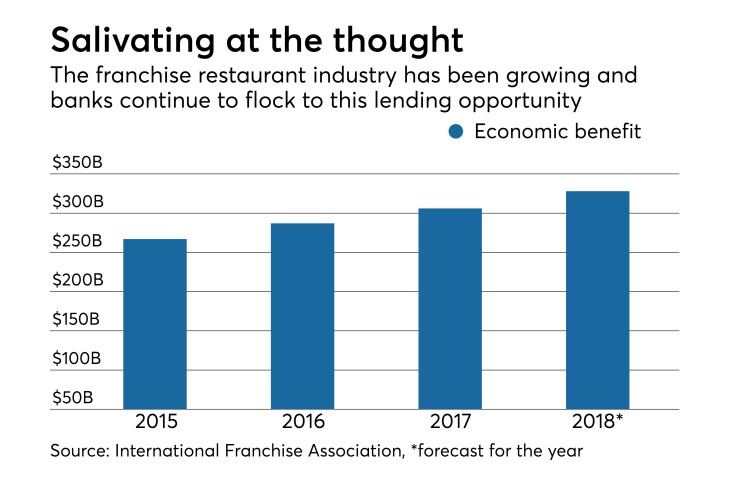Banks remain hungry for the buffet of options available in franchise restaurant lending.
Though some experts have raised concerns that the sector is becoming overbanked, franchises hold more appeal than independent restaurants for many lenders because they are easier to underwrite and they receive plenty of corporate support. Many banks complete these loans through the Small Business Administration’s 7(a) program.
Live Oak Bank, the nation’s No. 1 lender for the SBA’s 7(a) program, is the latest bank to sense an opportunity. The Wilmington, N.C.-based company recently launched a new division focused on the $330 billion space, hiring a seasoned restaurant banker to guide the effort.
“It’s a fragmented market with a wide range of borrowers,” said Jason Lumpkin, Live Oak’s general manager of emerging markets. “We’re looking for experienced operators with sound business plans and financial acumen.”

While Lumpkin declined to discuss Live Oak’s goals for the new vertical, the 19th it has entered, he said there are already deals in the pipeline and the bank is experiencing no difficulty grabbing the attention of potential borrowers. The $3.5 billion-asset company says it plans to serve every segment, from fast food to full-service restaurants.
“People are willing to talk to us,” Lumpkin said.
According to the SBA, food-and-drink establishments currently are the second-largest industry subsector in the 7(a) program, behind hotels and motels. Live Oak, which had closed $778 million in 7(a) loans through March 31, plans to fund much of its franchise business through the program.
“We like to think we’ve cracked the code” in 7(a) lending, Lumpkin said.
Banks have been traditionally reluctant to lend to mom-and-pop restaurants, but franchise eateries “are a different beast,” attorney Dennis Monroe said.
“They’re multi-unit retail businesses,” Monroe said. “Banks know what the values are. They know if there is a default, the [corporate parent] is going to be active in the resolution. They also know that there is some market always for the sale of franchise properties. It’s really a different world.”
Live Oak joins a number of other banks that have
Smaller players are entering the field as well, said Monroe, who noted that he met with four new SBA lenders in the field at a recent conference in Las Vegas. Monroe, who co-founded Monroe Moxness Berg in Minneapolis, works extensively with restaurant franchise entrepreneurs.
But this influx may be leading to a credit glut, some experts said.
“The outlook for franchise finance lending is mixed,” Rick Thompson, managing director for franchise finance at BMO Harris Bank, wrote in a research note last month. “While some lenders are experiencing weakness in their restaurant loans, there’s a surplus of newer lenders in the space.”
Monroe, likewise, said he worries things “are getting to the point of too many lenders.”
The International Franchise Association is projecting 7% growth for the restaurant franchise industry in 2018, which should make a lot of decisions to enter the space look good in the near term. If the cycle turns, however, lenders that failed to undertake proper due diligence could be in for a rough ride.
“I don’t think there is a real appreciation right now among the new lenders of the risk factors involved,” Monroe said. “There’s definitely a cycle here.”
Monroe was quick to add that he doesn’t count Live Oak in this category. The bank tapped Jeff Brock, a banker and investment banker with a deep background in restaurant franchise finance, to oversee its new division.
Bringing Brock’s expertise in-house means Live Oak “won’t have a big learning curve,” Monroe said, adding that Brock “knows everybody.”
Brock, who also worked at GE Capital Franchise Finance, said he “fell into food and beverage” about a decade while at JPMorgan Chase. In addition to his work for Live Oak, Brock continues to serve as a managing partner at Hargett Hunter Capital Management, a Raleigh, N.C.-based investment firm that focuses on restaurants.
Brock acknowledged the influx of lenders into restaurant franchise in recent years, but he said only a handful of what he termed “serious lenders” have followed Live Oak’s course and established dedicated teams focused solely on the industry.
Live Oak segments the different industries it lends to, labeling them verticals. Restaurant franchise represents the second outsize vertical the bank has entered since its
And more may be on the way.
“We’re looking at verticals all day, probably 20 at any one time,” Lumpkin said.





